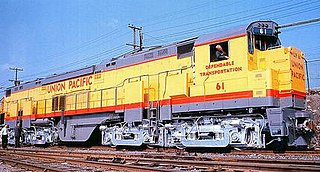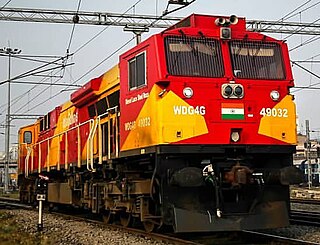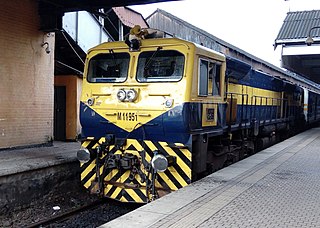A V20 engine is a twenty-cylinder piston engine where two banks of ten cylinders are arranged in a V configuration around a common crankshaft. Large diesel V20 engines have been used in diesel locomotives, haul trucks, electric generators and marine applications.

The SD80MAC was a 5,000 horsepower (3.7 MW) C-C diesel-electric locomotive. It was powered by a 20-cylinder version of EMD's 710G prime mover, and was the second diesel locomotive by GM-EMD to use a V20 engine, since EMD's SD45 series. It introduced a wide radiator housing similar to GE Transportation locomotives and the placement of dynamic brakes at the rear of the locomotive, which is a quieter location, features that were incorporated into the SD90MAC and SD70ACe models. Key spotting differences between the SD80MAC and SD90MAC include no external rear sandbox on the SD90MAC, no rear lighted number boards on the SD90MAC, and the placement of the front numberboards. The SD80MAC also had recessed red marker lights in the nose, an identifying feature unique to Conrail (CR) locomotives, although Norfolk Southern (NS) had removed the lights on most of their former Conrail engines.

The EMD SD90MAC is a model of 6,000 hp (4,470 kW) C-C diesel-electric locomotive produced by General Motors Electro-Motive Division (EMD). It is, with the SD80MAC, one of the largest single-engined locomotives produced by EMD, surpassed only by the dual-engined DDA40X.

The ALCO Century 855 was a model of 5,500 hp (4,101 kW) diesel-electric locomotive built in 1964 by the American Locomotive Company for the Union Pacific. The locomotive was notable for being ALCO's most powerful diesel-electric locomotive and, at the time, the most powerful diesel locomotive ever built, being surpassed by the 6,600-horsepower (4,922-kilowatt) EMD DDA40X in April 1969.

The Evolution Series is a line of diesel locomotives built by GE Transportation Systems, initially designed to meet the U.S. EPA's Tier 2 locomotive emissions standards that took effect in 2005. The first pre-production units were built in 2003. Evolution Series locomotives are equipped with either AC or DC traction motors, depending on the customer's preference. All are powered by the GE GEVO engine.

The EMD GP9 is a four-axle diesel-electric locomotive built by General Motors' Electro-Motive Division between 1954 and 1959. The GP9 succeeded the GP7 as the second model of EMD's General Purpose (GP) line, incorporating a new sixteen-cylinder engine which generated 1,750 horsepower (1.30 MW). This locomotive type was offered both with and without control cabs; locomotives built without control cabs were called GP9B locomotives.

The AC6000CW is a 6,000-horsepower (4,500 kW) diesel electric locomotive built between 1995 and 2001 by GE Transportation. It is among the world's most powerful single-engined diesel locomotives. The locomotive was designed for extremely high horsepower needs, such as pulling heavy coal and ore trains. Most examples were purchased by two railroads: Union Pacific and CSX.
The MK5000C is a 5,000 hp (3.7 MW) North American diesel-electric locomotive developed by MK Rail. At the time of its introduction in 1994, the MK5000C was the most powerful single prime mover diesel-electric locomotive ever made, a title it would hold for only for one year until GE Transportation released its competing 6,000 hp (4.5 MW) AC6000CW model in 1995.

The EMD 710 is a line of diesel engines built by Electro-Motive Diesel. The 710 series replaced the earlier EMD 645 series when the 645F series proved to be unreliable in the early 1980s 50-series locomotives which featured a maximum engine speed of 950 rpm. The EMD 710 is a relatively large medium-speed two-stroke diesel engine that has 710 cubic inches displacement per cylinder, and a maximum engine speed of 900 rpm.

The Indian locomotive class WDG-4 is a freight-hauling diesel-electric locomotive with AC electric transmission designed by General Motors Electro-Motive Diesel in 1997–1998 for Indian Railways, where they are classed as WDG-4. Derived from the EMD SD70MAC, it is powered by a 4,000 hp (3,000 kW) 16-cylinder EMD 710G3B prime mover. Thirteen were built by EMD as order #958647, and a further eight were exported in kit form and assembled in India. The class entered service in 1999. This locomotive is also famous for, and can be identified by the distinct Jet Aeroplane-like sounding capability of its EMD 710 prime mover.

The Indian locomotive class WDP-4 is a passenger-hauling diesel-electric locomotive with AC electric transmission designed by General Motors Electro-Motive Division and built by both GM-EMD and under license by Banaras Locomotive Works (BLW) of Varanasi, India for Indian Railways as the classes WDP4, WDP4B and WDP4D. The GT46PAC is a passenger version of the previous Indian Railways EMD GT46MAC freight locomotive. The locomotive has a 16-cylinder 710G3B diesel engine and is one of the fastest diesel-electric locomotives in service in Indian Railways.
The ALCO DL560C is a series of diesel-electric locomotive with AC electric transmission designed by the American Locomotive Company and produced under license by Banaras Locomotive Works (BLW) Varanasi, India for Indian Railways as their classes WDM-2, WDM-3A/2C, WDM-3D and WDG-3A for operation in India. The locomotive is fitted with a 16-cylinder ALCO 251 B,C diesel engine. In the early 1960s Indian Railways needed a reliable diesel workhorse to gradually replace its steam locomotive fleet. Equal numbers of ALCO's DL560C and EMD's G16 were chosen for trials. More locomotives of each of these were purchased for more trials. Indian Railways was keen on producing these locomotives in the country rather than depending on imports. EMD did not agree for a Transfer-of-Technology, while ALCO did. Thus ALCO DL560C was chosen for the job due to its easy maintenance, reliability and simple operation. And from then on vast numbers of this loco in different configurations have been produced and remain the main diesel traction power of Indian Railways.
The EMD 1010 or EMD 265 is a line of four-stroke diesel engines manufactured by Electro-Motive Diesel. The precursor to the 1010 was introduced around 1998 as the 265H or H-Engine. The H-engine was initially designed for use as a 6,300 hp (4,700 kW) 16 cylinder, the EMD SD90MAC; however, the early engines were found to be explosive, and unsuccessful in the market, with the proven EMD 710 2-stroke design being preferred. The EMD four-stroke engine was resurrected in 2015 to meet EPA Tier 4 emissions regulations.

Diesel Loco Shed, Gooty is an engine shed located in Gooty, Andhra Pradesh in India. It falls under the jurisdiction of Guntakal railway division of South Central Railway zone.
The Diesel Locomotive Factory, Marhowrah is a joint venture of GE Transportation of the US with Indian Railways for the production of 1000 high-power freight locomotives over a period of 10 years designed to run on Indian railway tracks. This factory is located at Marhaura and started manufacturing the locomotives from September 2018.

The Indian locomotive class WDG-4G is a class of dual-cabin freight-hauling diesel-electric locomotive used by the Indian Railways (IR). The locomotive is designed by GE Transportation and is based on its Evolution Series, which are used in North America. The class is meant for freight hauling and replaces the older American Locomotive Company (ALCO)-designed locomotives, which have been the mainstay diesels of Indian Railways since 1962. Equipped with a 12-cylinder fully turbocharged GEVO engine, it is claimed to be 50% more environmentally friendly than its predecessors and is the first in the country to be compliant with level one of the emission norms set by the International Union of Railways (UIC-1). The locomotive has two cabs for easy reversal, both of which are air conditioned.

The Indian locomotive class WDM-3D is a class of diesel-electric locomotive that was developed in 2003 by Banaras Locomotive Works (BLW), Varanasi for Indian Railways. The model name stands for broad gauge (W), Diesel (D), Mixed traffic (M) engine with 3300 horsepower (3D). The engine is classified WDM-3D though it outputs only 3300 hp and not 3400 hp as the name should suggest. They entered service in 2003. A total of 590+ WDM-3D were built at Banaras Locomotive Works (BLW), Varanasi between 2003 and 2016.

The Indian locomotive class WDG-3A is a class of diesel-electric locomotive that was developed in 1994 by Banaras Locomotive Works (BLW),Varanasi for Indian Railways. The model name stands for broad-gauge (W), Diesel (D), Goods traffic (G) engine, 3,100 hp (3A) locomotive. They entered service on 18 July 1995. A total of 1,164 WDG-3A units were built between 1994 and 2015 at BLW, Varanasi with a few units being produced by Diesel Loco Modernisation Works (DLMW) and Parel Workshop.

The Indian locomotive class WDG-6G is a class of diesel-electric locomotive used by the Indian Railways for freight duty. The locomotive is a higher power variant of the WDG-4G locomotive which was also designed by General Electric. The design platform is based on the GE Evolution Series and features a 4-stroke 16-cylinder fully turbocharged engine which delivers around 6,000 horsepower, making it the most powerful diesel locomotive of IR. It is the only 6,000 HP Diesel electric locomotive at 23t/axle weight, making it the lightest locomotive in its category in the world.

Class M11 is a mainline diesel-electric locomotive built by Banaras Locomotive Works, India, for use on Sri Lanka Railways and first delivered in 2018. This locomotive, clearly with its look, was developed from the WDG-4D locomotive of the Indian Railways, which is originally of 4,500 HP, as it uses a 16-cylinder variant of the EMD 710 prime mover. The HP was Down-tweaked to 3,000 using a 12-cylinder variant of the same engine, making it look and sound similar to British/European Railways' popular Class 66 EMD locomotive, but with AC-AC traction.



















